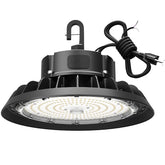Best Garage Lighting Ideas
The garage is a key feature of potential homeowners. With the utilities it provides, it is easy to understand why. The garage undertakes many functions that we need at home. We maximized the storage space on the walls and ceilings and set up workspaces for our project. From tools and pool accessories to lawn equipment and cars, everything has its purpose and location.
1. Lighting Requirements
-
Brightness (Luminance):
- General Lighting: 50–100 lux (for basic visibility).
- Task Lighting (e.g., workbench, car repairs): 300–500 lux (higher precision work may require 750+ lux).
- Motion-Activated Lighting: Useful for entry/exit areas.
-
Color Temperature (CCT):
- 4000K–5000K (Cool White to Daylight): Best for visibility and task-oriented work (e.g., car repairs, tool handling).
- 3000K–4000K (Neutral White): Suitable for general storage areas if a softer light is preferred.
-
- ≥70 CRI : Ensures accurate color representation (important for identifying car paint, wires, etc.).
-
Light Distribution:
- Uniform Illumination: Avoid dark spots by spacing fixtures evenly.
- Directional Lighting (for workbenches & storage): Use LED strip lights or adjustable spotlights.

2. Recommended Lighting Types
- LED Panel Lights (for general lighting): Energy-efficient, long lifespan (~50,000 hours), and low heat emission.
- LED High Bay Lights (for high ceilings): Ideal for garages with ceilings over 10 ft (3 m).
- LED Strip Lights (for under-cabinet & task lighting): Flexible and bright for workbenches.
- Motion-Sensor Lights (for security & convenience): Automatically turns on when movement is detected.
3. Power & Electrical Considerations
-
Voltage & Wiring:
- Standard 120V (US) / 230V (EU) for residential garages.
- GFCI (Ground Fault Circuit Interrupter) outlets near wet areas (e.g., if washing cars indoors).
-
Dimmability (Optional):
- Useful for adjusting brightness when needed (e.g., dimming for storage vs. full brightness for repairs).
4. Durability & Safety
-
IP Rating (Ingress Protection):
- IP65 (for damp environments): Protects against dust and water splashes (important if garage is exposed to moisture).
-
Impact Resistance:
- Choose polycarbonate or metal housing for durability against accidental bumps.
-
Heat Management:
- LEDs run cooler than fluorescents, but ensure proper ventilation if using high-power lights.
5. Energy Efficiency & Cost
-
Wattage vs. Lumens:
- 15W–30W LED bulbs can replace 100W incandescent bulbs while providing better brightness.
-
Smart Lighting (Optional):
- Wi-Fi/Bluetooth-enabled LEDs allow remote control via smartphone (e.g., scheduling, dimming).
6. Installation Tips
-
Ceiling Height Matters:
- 8–10 ft (2.4–3 m): Use standard LED panels or troffers.
- >10 ft (3 m+): Consider high bay lights for better light spread.
-
Avoid Glare:
- Use diffused or frosted lenses to prevent harsh shadows.
-
Zoning:
- Separate general lighting from task lighting (e.g., overhead lights + under-cabinet LEDs).
For a well-lit, energy-efficient, and safe lighting ideas for garage, prioritize:
✅ Brightness (50–500 lux depending on use)
✅ Cool white (4000K–5000K) for clarity
✅ High CRI (≥70) for accurate color recognition
✅ LEDs for longevity & efficiency
✅ Durable, moisture-resistant fixtures (IP65 if needed)
✅ Motion sensors for convenience & security
Would you like specific product recommendations based on garage size? Welcome come GGJIA LED Lighting Shop choose the led fixtures that suit you!!!😊😊








